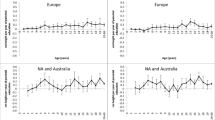Abstract
The most common alternative to a genetic explanation of left-handedness is that sinistrality arises because of birth stress factors. In a sample of 1398 subjects, the association between birth stress and left-handedness was confirmed. More importantly, it was found the left-handed mothers are more likely to have birth-stressed offspring and that the presence of any left-handed sibling increases the likelihood of a history of birth stress in the proband. This was interpreted as suggesting that a plausible alternative to the genetic explanation for the usual pattern of association observed in family studies of handedness (where a left-handed mother increases the probability of left-handed offspring) is that the mother-offspring association may actually be mediated by birth stress rather than representing heritable aspects of handedness.
Similar content being viewed by others
References
Aggleton, J. P., Kentridge, R. W., and Neave, N. J. (1993). Evidence for longevity differences between left- and right-handed men: An archival study of cricketers.J. Epidemiol. Commun. Health 47:206–209.
Annett, M. (1985).Left, Right, Hand and Brain: The Right Shift Theory, Lawrence Erlbaum Associates, London.
Bakan, P. (1990). Nonright-handedness and the continuum of reproductive casualty. In Coren, S. (ed.),Left-Handedness: Behavioral Implications and Anomalies. (Advances in Psychology, No. 67), North-Holland, Amsterdam, pp. 33–74.
Bakan, P. (1991). Handedness and maternal smoking during pregnancy.Int. J.Neurosci. 56:161–168.
Bryden, M. P. (1982)Laterality: Functional Asymmetry in the Intact Brain, Academic Press, New York.
Bryden, M. P., McManus, I. C., and Bulman-Fleming, M. B. (1994). Evaluating the empirical support for the Geschwind-Behan-Galaburda model of cerebral lateralization.Brai Cognit. 26:103–167.
Colburne, K. A., Kaplan, B. J., Crawford, S. G., and McLeod, D. R. (1993). Hand assymmetry: Its relationship to nonright handedness.J. Clin. Exp. Neuropsychol 15:67.
Corballis, M. (1983).Human Laterality, Academic Press, New York.
Coren, S. (1990). Relative risk of left-handedness in offspring as a function of maternal age at parturition.N. Engl. J. Med. 322:1673.
Coren, S. (1992). Are left-handers an endangered species? Invited address delivered to the Western Psychological Association meetings, Portland, OR, May.
Coren, S. (1993a).The Left-Hander Syndrome: The Causes and Consequences of Left-Handedness, Vintage Books, New York, pp. i-x, 1–317.
Coren, S. (1993b). The Lateral Preference Inventory for measurement of handedness, footedness, eyedness and earedness: Norms for young adults.Bull. Psychon. Soc. 31:1–3.
Coren, S. (1994a). Are fingerprints a genetic marker for handedness?Behav. Genet. 24:141–148.
Coren, S. (1994b). Handedness and allergic response.Int. J. Neurosci. 76:231–236.
Coren, S. (1994c). The diminished number of older left-handers: Differential mortality or social-historical trend?Int. J. Neurosci. 75:1–8.
Coren, S., and Halpern, D. F. (1991). Left-handedness: A marker for decreased survival fitness.Psychol. Bull. 109: 90–106.
Coren, S., and Porac, C. (1977). Fifty centuries of right-handedness: The historical record.Science 198:631–632.
Coren, S., and Porac, C. (1978). The validity and reliability of self-report items for the measurement of lateral preference.Br. J. Psychol. 69:207–211.
Coren, S., and Porac, C. (1980a). Family patterns in four dimensions of lateral preference.Behav. Genet. 10:333–348.
Coren, S., and Porac, C. (1980b). Birth factors and leterality: The effects of birth order, parental age and birth stress on four indices of lateral preference.Behav. Genet. 10:123–138.
Coren, S., and Searleman A. (1990). Birth stress and left-handedness: The rare trait marker model. In Coren, S. (ed.),Left-Handedness: Behavioral Implications and Anomalies. (Advances in Psychology, No. 67), North-Holland, Amsterdam, pp. 3–32.
Coren, S., Porac, C., and Duncan, P. (1979). A behaviorally validated self-reported inventory to assess four types of lateral preference.J. Clin. Neuropsychol. 1:55–64.
Coren, S., Searleman, A., and Porac, C. (1982). The effects of specific birth stressors on four indexes of lateral preference.Can. J. Psychol. 36:478–487.
Elliman, A. M., Bryan, E. M., Elliman, A. D., Walker, J., and Harvey, D. R. (1991). Coordination of low birthweight seven-year-olds.Acta Pediat. Scand. 80:316–322.
Ellis, L., and Peckham, W. (1991). Prenatal stress and handedness among offspring.Pre-Peri-Natal Psychol. J. 6:135–144.
Geschwind, N., and Galaburda, A. M. (1987).Cerebral Lateralization: Biological Mechanisms, Associations, and Pathology, MIT Press, Cambridge, MA.
Habib, M., Touze, F., and Galaburda, A. M. (1990). Intrauterine factors in sinistrality A review. In Coren, S (ed.),Left-Handedness: Behavioral Implications and Anomalies, Advances in Psychology, No. 67, North-Holland, Amsterdam, pp. 99–130.
Halpern, D. F., and Coren, S. (1988). Do right-handers live longer?Nature 333:213.
Halpern, D. F., and Coren, S. (1991). Hand preference and life span.N. Engl. J. Med. 324:998.
Mcmanus, I. C. (1985). Handedness, language dominance and aphasia: A genetic model.Psychological Medicine Monograph: Supplement 8, Cambridge University Press, Cambridge.
Porac, C., and Coren, S. (1981).Lateral Preferences and Human Behavior, Springer-Verlag, New York.
Rogerson, P. A. (1993). On the relationship between handedness and longevity.Soc. Biol. 40:283–287.
Searleman, A., Porac, C., and Coren, S. (1982). The relationship between birth stress and writing hand posture.Brain Cognit. 1:158–164.
Searleman, A., Porac, C., and Coren, S. (1989). The relationship between birth order, birth stress handedness and lateral preference: A critical review.Psychol. Bull. 105:397–408.
Seidman, D. S., Slater, P. E., Ever-Hadani, P., and Gale, R. (1987). Accuracy of mothers' recall of birthweight and gestational age.Br. J. Obstet. Gynaecol. 94:731–735.
Semenov, S. A. (1964).Prehistoric Technology, Cory, Mc-Adams & Mackay, London.
Williams, C. S., Buss, K. A., and Eskenazi, B. (1992). Infant resuscitation is associated with an increased risk of lefthandedness.Am. J. Epidemiol. 136:277–286.
Author information
Authors and Affiliations
Rights and permissions
About this article
Cite this article
Coren, S. Family patterns in handedness: Evidence for indirect inheritance mediated by birth stress. Behav Genet 25, 517–524 (1995). https://doi.org/10.1007/BF02327575
Received:
Accepted:
Issue Date:
DOI: https://doi.org/10.1007/BF02327575




